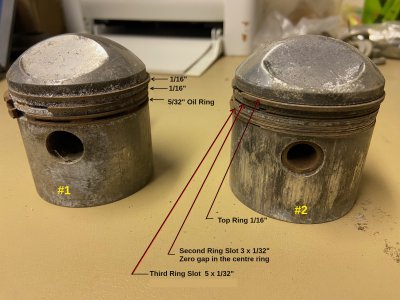- Joined
- May 27, 2016
- Messages
- 3,480
I am hoping there are some engine experts here.
The picture is of of pair of pretty rough looking vintage (1930s thru 1940s) pistons from motor cycles of that era. The engines were 350cc air-cooled horizontally opposed types. Given #1 is not the same as #2, I don't expect they came from the same bike model, but they both do come from the same casting as the ones I mentioned in the "Pistons problemo!" thread. One has a ring set I have never seen before, and I don't understand how it works.
These messed up pistons are +0.030", which means there is some scope for them to be cleaned up donor parts in a +0.020" bore, basically by removing 0.005". That is, except for the rings. I know nothing about rings technology of the time, and I would like to discover what these are.
Piston #1 is looking more modern, I think, though my originals had the oil control ring down on the skirt near the bottom.
Piston #2 is the complete mystery. The 3 x 1/32" rings in the second slot have gaps 1/8", and then 1/4" cut at an angle, for the first and third. The second of the set, "in between has zero gap, the slit also at the (about) 20° angle. By itself, the slit is quite hard to find, until you flex the ring.
The wider, third ring in Piston #2, just above the wrist pin is a set of 5 x 1/32" rings, all with 1/4" gaps, spread about the circumference. I did find the series of oiling holes under the set of 5, though they were carbon clogged, and that may have had something to do with the overheated bore scoring "event". I would much appreciate any information about these strange (to me) ring things.

The picture is of of pair of pretty rough looking vintage (1930s thru 1940s) pistons from motor cycles of that era. The engines were 350cc air-cooled horizontally opposed types. Given #1 is not the same as #2, I don't expect they came from the same bike model, but they both do come from the same casting as the ones I mentioned in the "Pistons problemo!" thread. One has a ring set I have never seen before, and I don't understand how it works.
These messed up pistons are +0.030", which means there is some scope for them to be cleaned up donor parts in a +0.020" bore, basically by removing 0.005". That is, except for the rings. I know nothing about rings technology of the time, and I would like to discover what these are.
Piston #1 is looking more modern, I think, though my originals had the oil control ring down on the skirt near the bottom.
Piston #2 is the complete mystery. The 3 x 1/32" rings in the second slot have gaps 1/8", and then 1/4" cut at an angle, for the first and third. The second of the set, "in between has zero gap, the slit also at the (about) 20° angle. By itself, the slit is quite hard to find, until you flex the ring.
The wider, third ring in Piston #2, just above the wrist pin is a set of 5 x 1/32" rings, all with 1/4" gaps, spread about the circumference. I did find the series of oiling holes under the set of 5, though they were carbon clogged, and that may have had something to do with the overheated bore scoring "event". I would much appreciate any information about these strange (to me) ring things.

Last edited:


